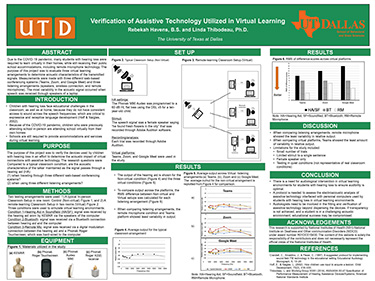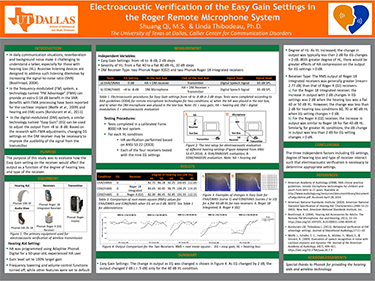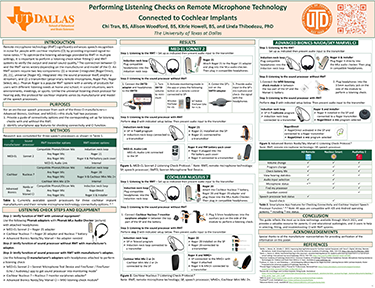Shuang Qi and Linda Thibodeau– Artificial Intelligence and Hearing Aids
Poster presented at Conference on Advances in data Science: Theory, Methods, and Computation, October 2022
Hearing aid (HA) is reliable to deal with hearing impairment. Recently, advanced artificial intelligence (AI), machine learning (ML), or neural network (NN) algorithms are widely applied into health care fields, including speech and hearing health. It is said that intelligent HA will be the next revolution. To report recent proceedings in this field, this review included the application and benefits of AI, ML, or NN technologies associated in the design or implementation of HA technologies, and their impact on individual performance.
Emma Freeman, Rebekah Havens and Linda Thibodeau – Comparing Speech Recognition With Remote Microphone Technology Using KEMAR and Voice-to-Text Testing
Poster presented at the American Academy of Audiology Annual Conference, April 2022
During the COVID-19 pandemic, conducting research was extremely difficult with no in-person participants to test. Creative solutions were needed to continue research. This study presents an option to test real world conditions using voice to text, KEMAR and wireless technology without a patient present. The transcription application “Otter” was used due to its accuracy to represent a participant’s responses. A Phonak Marvel hearing aid programmed for a flat 60dBHL hearing loss fit on KEMAR represented a patient with a moderate hearing loss. This setup was deemed a viable research option when in person testing is not available or necessary.
Shuang Qi and Linda Thibodeau – Electroacoustic Verification of the Easy Gain Settings in the Remote Microphone System
Poster presented at the American Academy of Audiology Annual Conference, April 2022
Remote microphone systems are designed to facilitate communication by increasing the signal-to-noise ratio through a transmitter and a receiver. Adjusting Easy Gain (EG) settings on the digital-modulated (DM) receiver may be necessary to improve the audibility of the signal from the transmitter. The purpose was to evaluate the effects of EG settings on the output as a function of the degree of hearing loss and receiver type using electroacoustic verification in a Roger DM system. EG settings, degree of HL, and DM receiver-type interact with each other such that electroacoustic verification is necessary to determine appropriate settings.
Rebekah Havens and Linda Thibodeau – Verification of Assistive Technology Utilized in Virtual Learning
Poster presented at the American Academy of Audiology Annual Conference, April 2022
Due to the COVID-19 pandemic, many students with hearing loss were required to learn virtually in their homes, while still receiving their public school accommodations, including remote microphone technology. The purpose of this project was to evaluate three virtual learning arrangements to determine acoustic characteristics of the transmitted signals. Measurements were made with three different web-based conferencing systems (Teams, Zoom, and Google Meet) and three listening arrangements (speakers, wireless connection, and remote microphone). The most variability in the acoustic signal occurred when speech was received through speakers of a laptop.
Chi Tran and Linda Thibodeau – Pandemic Communication Breakthrough with Clear Masks and Remote microphone Technology
Poster presented at the American Academy of Audiology Annual Conference, April 2022
Communication since the era of mask mandates has been particularly challenging due to the acoustic degradation and visual obstruction of face masks. Allowing access to visual cues using the clear masks and improving auditory signal-to-noise ratio using the remote microphone technology have proven to significantly facilitate communication in the presence of noise. Moreover, listeners’ confidence significantly improved when the speaker employed these strategies. To reduce communication barriers, the use of clear masks and remote microphone technology is strongly recommended in noisy settings such as hospitals, workplaces, classrooms, and public places.
Shuang Qi and Linda Thibodeau – Electroacoustic Verification of the Easy Gain Settings in the Roger Remote Microphone System
Poster presented at the Texas Academy of Audiology Annual Conference, October 2021
In a digital-modulated remote microphone system, adjustment of Easy Gain (EG) settings on the receiver may be necessary to improve the audibility of the signal from the transmitter. This study aimed to evaluate how the EG setting on the receiver would affect the output as a function of the degree of hearing loss and type of the receiver. The electroacoustic verification results showed interactions among these three factors.
Chi Tran, Allison Woodford, Kitrie Howell, and Linda Thibodeau – Performing Listening Checks on Remote Microphone Technology Connected to Cochlear Implants
Poster presented virtually at the American Academy of Audiology Annual Conference, April 2021
Download the poster
Listen to the recorded presentation
Performing a listening check is important to ensure the appropriate function of remote microphone technology (RMT) when connected to cochlear implants (CI). Protocols and features vary among manufacturers. Manufacturer websites and manuals were used to produce a guide illustrating the differences in listening check protocols for Roger systems connected with CIs from three manufacturers: Advanced Bionics, CochlearTM, and MEDEL. Smartphone app features for connectivity control are explained along with applications for RMT with CIs.
Lucy Hinderliter, Emma Freeman, Linda Thibodeau – Mobile Phone Features offered by Phone Companies to Individuals with Hearing Loss
Poster presented virtually at the American Academy of Audiology Annual Conference, April 2021
Download the poster
Listen to the recorded presentation
Mobile phone hearing loss features by company
The Hearing Aid Compatibility Act of 1988 mandates that individuals with hearing loss have more options of phones that work with hearing aids and cochlear implants. There are several considerations when purchasing a mobile phone which includes phone ratings, trial periods, added features, deaf or hard of hearing plans, and accessories. The considerations will be addressed for four major cell providers: Verizon Wireless, Sprint, AT&T, and T-Mobile. Additional assistance through providers of captioned phones or apps will be specified.
Kortney Bush, Megan Cantwell and Linda Thibodeau – Verification of Remote Microphones Paired to Implants by Audiologists Who are Hard-of-Hearing
Poster presented virtually at the American Academy of Audiology Annual Conference, April 2021
Download the poster or a closeup of Figure 1
Listen to the recorded presentation
It is critical for audiologists to perform listening checks on remote microphone systems that are paired with cochlear implants, given that electroacoustic verification protocols commonly used with hearing aids cannot be performed. Special arrangements should be considered for audiologists who are deaf or hard of hearing. The purpose of this research was to develop procedures to make listening checks more accessible for audiologists who are deaf or hard of hearing by using connections to Roger technology.
Kortney Bush and Linda Thibodeau – Virtual Evaluation of Speech Recognition in Noise with Live Listen Feature on the iPhone
Poster presented virtually at the American Academy of Audiology Annual Conference, April 2021
Download the poster
Listen to the recorded presentation
Several smartphone-based applications exist to improve the signal-to-noise ratio when communicating in background noise. The research question was whether Apple’s smartphone-based application, “Live Listen,” improves speech recognition in noise, in a remote test paradigm. HINT sentences were presented in multitalker babble with and without the “Live Listen” assistive feature. The benefit in speech recognition provided by this smart-phone feature may provide a foundation for outcome measures in virtual aural rehabilitation.
Rebekah Havens and Linda Thibodeau – Speech in Noise Recognition by Voice to Text Applications
Poster presented virtually at the American Academy of Audiology Annual Conference, April 2021
Download the poster
Listen to the recorded presentation
Because of the COVID-19 pandemic and the mask mandate, persons with hearing loss struggle to hear in their everyday listening environments due to the absence of speech reading cues. The purpose of this project was to obtain results from three voice-to-text software applications (Live Transcribe, Otter, and Dragon Anywhere) on an iPhone to determine their accuracy in background noise. The applications performed similarly in quiet but varied in noise, with the Otter application providing the greatest accuracy.
Chi Tran — Evaluation of Important Factors in Electroacoustic Verification of Wireless Technology
Poster presented virtually at the Texas Academy of Audiology Annual Conference, October 2020
Download the poster
Listen to Chi Tran’s recorded presentation
Electroacoustic verification of wireless technology systems has an important role in the effectiveness and consistency of auditory rehabilitation. Factors that can affect electroacoustic analysis with wireless digital modulation (DM) systems include directional features of the transmitter and settings on the DM receiver. Despite control for these, variability was noted across 18 DM receivers when tested with the same transmitter and hearing aid. The results suggest the need for regular electroacoustic verification of wireless technology systems.
Rebekah Havens — Electroacoustic Verification of Hearing Aids with Smartphone Connectivity
Poster presented virtually at the Texas Academy of Audiology Annual Conference, October 2020
The purpose of this project was to obtain electroacoustic verification of Made for iPhone hearing aids (HA) which function with an iPhone as a remote microphone (RM) in an effort to develop an evaluation protocol. While ANSI S3.47 provides instructions for the electroacoustic evaluation of assistive devices, there are no protocols for the evaluation of HAs that connect with smartphones used as a RM. Results suggested that electroacoustic results may not be maintained when aid is connected to a smartphone.
David McCullough, Emma Freeman — Testing Hearing Thresholds using Smartphone-Based App
Posted presented at the UTD Doctorate of Audiology Program Specialized Topics in Acoustics Research, February 2020
The purpose of this study is to consistently achieve thresholds from a smartphone application that are in line with a GSI-61 audiometer calibrated for clinical environments. While the GSI-61 meets industry-grade certification independent applications are subject to the standards of developers. Thresholds from persons with normal hearing indicated a lack of agreement with the clinical protocol which led to adjustments to the algorithm. A second version of the app is currently being tested since results from the first version revealed a need for improvement.














You must be logged in to post a comment.